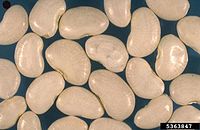
Photo from wikipedia
This paper is about the cellular responses of plants to chewing insect attacks. We deployed a recently developed experimental system to monitor the responsiveness of Arabidopsis thaliana (Arabidopsis) to the… Click to show full abstract
This paper is about the cellular responses of plants to chewing insect attacks. We deployed a recently developed experimental system to monitor the responsiveness of Arabidopsis thaliana (Arabidopsis) to the application of oral secretion (OS) from Lepidopteran generalist herbivore Spodoptera litura (S. litura). Oral secretion from S. litura contains gut regurgitant and saliva. We identified significant differences in the wound closure morphologies (e.g., dried and sealed tissue) between mechanically damaged leaves with and without an application of S. litura OS at the site-of-injury. Experimental controls were mechanically wounded leaves. Wounds were walled off by visible vertical cross sections. Cell death was restricted to the immediate areas of the wounds. In contrast, mechanically damaged leaves treated with S. litura OS did not display a clear sealing pattern due to an absence of a defined vertical cross section at the wound site. Notably, OS treated leaves exhibited a wider area of visible premature senescence (the declining of chlorophyll content caused by death of chloroplasts) around the injury than controls. More pronounced senescence was also observed around the injury in S. litura OS treated wounds than in controls. Heat inactivated S. litura OS elicited a similar response to non-heat inactivated samples. The causal compound is heat stable and thus not a protein. Our results suggest that S. litura OS: (1) inhibited wound recovery responses in leaves; (2) promoted senescence around injured areas. The function of senescence may be to relocate nutritional resources to support plant survival when attacked.
Journal Title: Plant biotechnology
Year Published: 2018
Link to full text (if available)
Share on Social Media: Sign Up to like & get
recommendations!